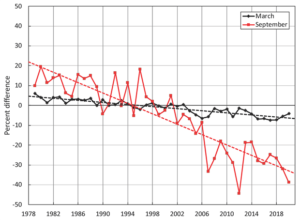by Polar Bear Science, Jan 8, 2021 in WUWT
As well as summarizing sea ice changes, NOAA’s 2020 Arctic Report Card features two reports that document the biggest advantage of much less summer sea ice than there was before 2003: increased primary productivity. Being at the top of the Arctic food chain, polar bears have been beneficiaries of this phenomenon because the Arctic marine mammals they depend on for food – seals, walrus and bowhead whales – have been thriving despite less ice in summer.

In the sea ice chapter (Perovich et al. 2020), my favourite of all the figures published is the graph of September vs. March sea ice (above). As you can see, March ice extent has been virtually flat (no declining trend) since 2004. And as the graph below shows, September extent has been without a trend since 2007, as NSIDC ice expert Walt Meier demonstrated last year (see below): it doesn’t take much imagination to see that the value for 2020 from the graph above (the second-lowest after 2012) hasn’t changed the flat-trend line.
…
